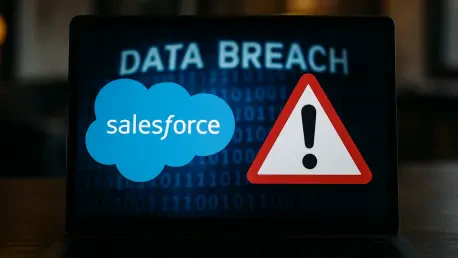The recent data breach involving Salesforce, a titan in the cloud computing and SaaS industry, has sent a powerful jolt through the business world, exposing critical vulnerabilities in even the most trusted platforms. As a provider of essential tools for customer relationship management and data analytics, Salesforce handles an immense volume of sensitive information, making it an attractive target for cybercriminals such as the hacking group Scattered LAPSUS$ Hunters, who claimed responsibility for stealing data from numerous companies. This unsettling incident, brought to light through expert analysis, serves as more than just a cautionary tale—it’s a clarion call for both providers and enterprises to confront systemic risks in cloud ecosystems. The breach didn’t directly compromise Salesforce’s core infrastructure, but rather exploited weaknesses in third-party integrations and customer environments, revealing how interconnected systems can amplify the impact of a single flaw. This discussion delves into the profound implications of the event and uncovers vital insights for strengthening cloud security in an increasingly digital landscape.
Unmasking Vulnerabilities in Cloud Ecosystems
The Salesforce breach lays bare a fundamental truth about cloud computing: interconnected systems, while powerful, harbor significant vulnerabilities that can be exploited with devastating effect. As a central hub for countless organizations worldwide, Salesforce facilitates seamless data sharing and collaboration, but this very strength becomes a liability when a single breach ripples across an entire network. The attackers zeroed in on third-party integrations rather than the core platform, demonstrating that the security of a shared cloud environment hinges on its weakest link. Such a reality demands a reevaluation of how interconnectedness is managed, pushing businesses to recognize that a flaw in one part of the ecosystem can jeopardize data far beyond the initial point of entry. This incident underscores the urgency of addressing these systemic risks before they cascade into broader crises.
Moreover, the nature of this breach highlights the expanded attack surface created by multitenant cloud architectures. With numerous businesses relying on Salesforce for critical operations, the sheer volume of data and the web of connections create countless opportunities for malicious actors to infiltrate. Unlike traditional on-premises systems where risks might be contained, cloud platforms amplify exposure due to their shared nature. The exploitation of external tools connected to Salesforce reveals how even robust defenses can be undermined by peripheral weaknesses. This serves as a stark reminder that comprehensive security must extend beyond the core infrastructure to encompass every touchpoint in the ecosystem. Companies must now prioritize mapping out these connections and fortifying them against potential threats, ensuring that no overlooked component becomes a gateway for attackers.
The Fragility of Trust in SaaS Platforms
Trust forms the bedrock of the SaaS industry, yet the Salesforce breach has severely tested this foundation, leaving enterprises questioning the reliability of cloud providers. Businesses turn to platforms like Salesforce because they often lack the internal expertise or resources to develop comparable systems, placing immense faith in these providers to safeguard their most sensitive data. When a breach occurs, even if not directly tied to the core system, that confidence is shattered, prompting doubts about the wisdom of cloud-first strategies that dominate modern operations. The fallout from this incident isn’t merely technical—it’s deeply psychological, as organizations grapple with the fear that their critical assets might not be as secure as promised. This erosion of trust poses a significant challenge to the perception of cloud solutions as dependable utilities.
Beyond immediate concerns, the long-term implications of diminished trust could reshape the SaaS landscape in profound ways. Enterprises may hesitate to fully commit to cloud platforms, potentially slowing the adoption of innovative tools that drive efficiency and growth. The reputational damage from such incidents extends to the entire industry, as skepticism about one provider’s security can cast a shadow over others. This breach serves as a pivotal moment, urging SaaS companies to not only bolster their defenses but also transparently communicate their efforts to rebuild confidence. For businesses, it’s a call to reassess vendor relationships and demand greater accountability, ensuring that trust is backed by tangible security measures. The path forward requires a delicate balance of rebuilding faith while acknowledging the inherent risks of relying on external platforms for core operations.
Shared Responsibility in Securing the Cloud
A critical lesson from the Salesforce breach is the importance of the shared responsibility model in cloud security, where both providers and customers must actively contribute to safeguarding data. While Salesforce bears the duty of maintaining a secure infrastructure, enterprises are equally accountable for managing access controls, monitoring for unusual activity, and educating employees about potential risks like phishing or social engineering. The breach revealed how human error often serves as an entry point for attackers, exploiting simple lapses in judgment or oversight. This dynamic emphasizes that cybersecurity cannot be outsourced entirely to providers—it demands a collaborative effort where every stakeholder plays a vital role. Ignoring this shared burden risks leaving gaping holes in defenses that hackers are all too eager to exploit.
Equally significant is the need for proactive measures on both sides to strengthen this partnership. For customers, this means implementing strict policies around data access and regularly auditing their environments for vulnerabilities, especially in areas like third-party tool usage. Providers, meanwhile, must offer robust tools and guidance to help users uphold their end of the security bargain, ensuring that best practices are accessible and actionable. The Salesforce incident illustrates how a breakdown in this shared model can lead to catastrophic outcomes, as attackers often target the intersection of provider and customer responsibilities. Moving forward, fostering a culture of mutual accountability will be essential to close these gaps, transforming cloud security from a point of contention into a unified front against evolving cyber threats.
Risks Posed by Third-Party Integrations
One of the most alarming revelations from the Salesforce breach is the significant risk posed by third-party integrations, which often serve as unnoticed backdoors for cybercriminals. Tools connected to the platform, such as Salesloft Drift, became conduits for attackers despite the core system remaining intact, exposing a harsh reality: even the most fortified platforms can be undermined by external components. This incident highlights the necessity for businesses to rigorously vet every tool or service linked to their cloud environments, prioritizing security over the convenience of rapid integration. Failing to scrutinize these connections can transform a valuable extension of functionality into a devastating point of failure, undoing layers of defense with a single exploit.
Furthermore, the reliance on third-party solutions in modern business workflows amplifies the stakes of this vulnerability. As companies expand their tech stacks to include specialized tools for marketing, sales, and analytics, each new integration broadens the attack surface, creating additional entry points for malicious actors. The Salesforce breach serves as a cautionary example of how these external dependencies, if not properly managed, can compromise entire ecosystems. Enterprises must adopt a proactive stance, conducting thorough security assessments and demanding transparency from vendors about their protective measures. Regular penetration testing of these integrations can also uncover weaknesses before they are exploited, ensuring that the pursuit of innovation doesn’t come at the expense of safety.
Driving Security Innovation in SaaS
The Salesforce breach has cast a spotlight on the urgent need for SaaS providers to prioritize security innovation with the same intensity as feature development. In complex multitenant environments where data from numerous organizations coexist, traditional defenses often fall short against sophisticated cyber threats. The incident calls for the creation of advanced threat detection and response systems tailored to the unique challenges of cloud platforms, capable of identifying and neutralizing breaches before they escalate. Providers must treat security as a core pillar of their offerings, not an afterthought, to protect the backbone of modern business operations. This shift in focus is no longer optional but a fundamental requirement in an era of relentless cyberattacks.
Additionally, the competitive landscape of SaaS demands that providers stay ahead of evolving threats through continuous improvement and adaptation. Investing in cutting-edge technologies, such as machine learning for anomaly detection or zero-trust architectures, can significantly enhance the resilience of cloud systems. The Salesforce incident underscores that complacency in security development risks not only data loss but also the trust of an entire customer base. Providers must also collaborate with cybersecurity experts and share insights on emerging threats to build industry-wide defenses. By embedding security into the DNA of their platforms, SaaS companies can transform vulnerabilities into opportunities for leadership, setting new standards that reassure users and deter attackers alike.
Empowering Enterprises to Strengthen Defenses
For enterprises relying on cloud platforms like Salesforce, the breach serves as a stark reminder that adaptation and vigilance are essential to surviving in a dynamic threat landscape. Companies must revisit their cloud strategies, ensuring that robust policies govern data access and that regular audits identify potential risks before they are exploited. Conducting penetration testing on a consistent basis can reveal hidden weaknesses, allowing for timely remediation. Beyond technical measures, fostering a security-conscious culture among employees is critical, as human error often opens the door to attackers. Training staff to recognize phishing attempts and adhere to best practices can significantly reduce vulnerabilities, turning a workforce into a line of defense rather than a liability.
Equally important is the need for enterprises to take a hard look at their dependency on cloud solutions and balance innovation with caution. While platforms like Salesforce offer unparalleled efficiency, the breach illustrates that over-reliance without adequate safeguards can lead to catastrophic outcomes. Businesses should diversify their risk by implementing hybrid approaches where feasible, maintaining critical data backups outside primary cloud environments. Collaborating with providers to customize security settings tailored to specific needs can also mitigate exposure. The lesson here is clear: enterprises must act decisively, treating security as a strategic priority rather than a reactive concern, to ensure that powerful tools don’t become points of failure in the face of evolving threats.
A Turning Point for Cloud Security
Reflecting on the Salesforce data breach, it becomes evident that the incident acted as a powerful catalyst for transformation within the cloud computing industry. It exposed the growing sophistication of cyberattacks targeting SaaS platforms, fueled by the centralized nature of data in these environments. The event served to unite stakeholders in recognizing that the stakes had never been higher, as businesses continued to digitize at an unprecedented pace. It was a moment that demanded a collective response, compelling providers and users alike to fortify systems against increasingly cunning threats. Looking back, this breach marked a critical juncture, reshaping how security is perceived and prioritized in the digital realm.
Moving forward, the industry must seize this opportunity to implement lasting change, focusing on actionable strategies to prevent future breaches. Providers should lead by integrating state-of-the-art security protocols and fostering transparent communication with customers about protective measures. Enterprises, in turn, need to commit to rigorous oversight of their cloud environments and invest in ongoing education to empower their teams. Collaborative efforts, such as sharing threat intelligence across the sector, can further enhance resilience. The path ahead lies in building a unified front, ensuring that the lessons learned from this incident translate into stronger, more secure cloud ecosystems capable of withstanding the challenges of tomorrow.









